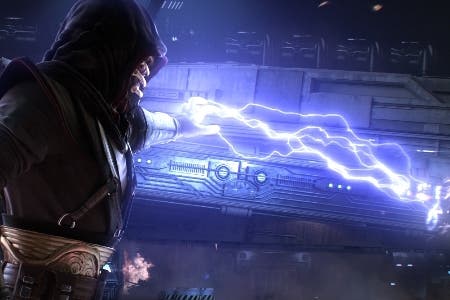Star Wars: The Old Republic re-review
Little new hope.
Time hasn't been kind to The Old Republic. It certainly doesn't feel like a game that came out last Christmas, even if at launch its technology and largely reskinned Warcraft mechanics were more a base for BioWare to flex its narrative muscles with than a big leap forward for massively multiplayer games. Now, not even a year later, with the game recently turned free-to-play, going back to explore its worlds feels like archeology. Sometimes palaeontology. And the story that BioWare hoped to tell is unlikely to have a happy ending.
From launch, The Old Republic's key problem was that it was stuck serving two very different masters - the personal storylines it wanted everyone to focus on and the subscription fee whose dark shadow loomed over all. It offered narrative beats far beyond what any other MMO had dared, with a choice of eight different character classes, each with a unique, branching story. It then suffocated them with padding, slow levelling and an endless array of tedious stock quests that no amount of dialogue could jazz up. (You also had to spend a ridiculous amount of time running around to check in on people despite owning a bloody cellphone. That bugged me. Just saying.)
None of this has changed. What has, though, is that story is no longer an exciting novelty, while World of Warcraft: Mists of Pandaria, Guild Wars 2 and The Secret World have all surpassed The Old Republic's stilted dialogue, basic cinematography and forgettable characters. In Pandaria, phasing and scripting comes together for a more dynamic experience with a good sense of humour. Guild Wars 2 remembers that an MMO is expected to be a multiplayer experience first, layering its plotting and single-player content on top far more skilfully. The Secret World offers infinitely better writing. Yes, they all have issues, especially with pacing. They still trounce The Old Republic's attempts, rendering it drier than moondust.
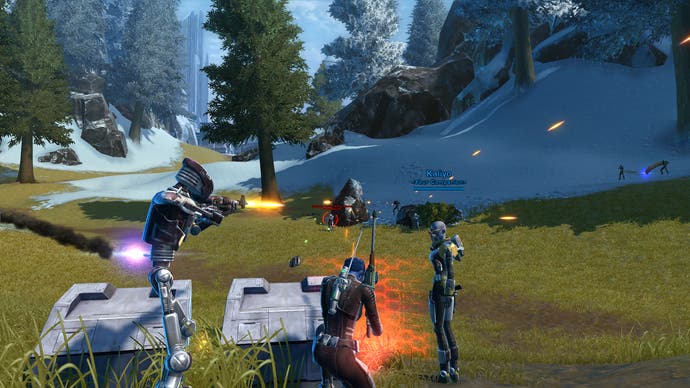
With its only real selling point reduced to offering mediocre storytelling in a sterile, lifeless version of the Star Wars universe, The Old Republic doesn't have much to fall back on. As a game, it shoots for adequacy and often hits it. Even so, it's a clumsy adequacy weighed down by the fact that, while it does provide player-versus-player and story-based dungeons and endgame content as the genre demands, most of its best content would have been much more enjoyable done as a single-player game. The only real advantage of getting it as an MMO is that we were never likely to see, say, Sith Inquisitors of the Old Republic, making this the only way for most of the classes to strut their stuff.
These stories are still the best reason to play The Old Republic, especially as the new free-to-play version gives you access to all of them in their entirety. BioWare goes for quantity over quality in a big way for most of the game, but these tales are decently tight and offer plenty of flexibility. As an Imperial Agent for instance, you're a spy and you work for the baddies - your boss being an immature Sith Lord who isn't called Darth Joker, but should be. It's up to you whether you play that role as a backstabbing, ruthless bastard or an honourable agent repairing delicate situations from the shadows.
I would play an RPG devoted to these guys, ideally one with lots of Alpha Protocol mixed in - and most of the rest have their moments too. Even with The Old Republic's problems, I'd recommend downloading the free client to try one of these out, and dip into a couple of the narrative-driven Flashpoints (dungeons) if you haven't already seen how they're handled. It's just a shame that most of your time is still spent on cookie-cutter questing that's several years past its prime.
"BioWare has developed some of the most embarrassing freemium approaches since Vindictus started selling sexy lingerie and calling it 'Inner Armor'."
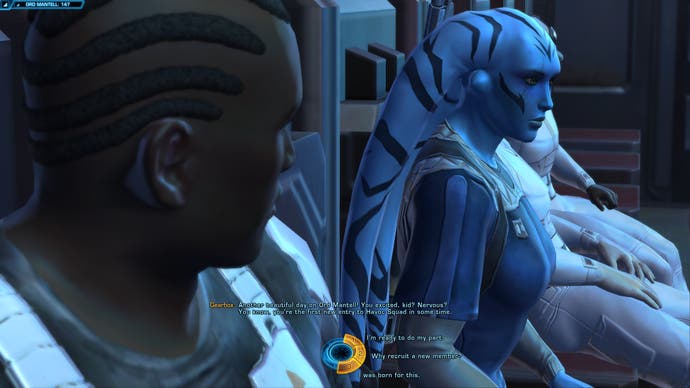
Beyond the levelling areas, you can access almost everything except Operations (raids) and a recently premium area for free, at least to some extent. However, an extra purchase is needed to let you equip or loot advanced gear you find, and you have to buy weekly passes for unlimited access to the Warzones (PVP) and Space Missions (worthless rail shooting). This isn't a perfect system, and if you find yourself buying more than a couple of weekly passes every month then then you may as well just bite the bullet and become a subscriber. It's a reasonable taster though, at least for now.
Unfortunately, that's where the good news ends. As initially generous as The Old Republic seems, it soon becomes clear that BioWare has developed some of the most embarrassing freemium approaches that I've seen since Vindictus started selling sexy lingerie and calling it "Inner Armor". It's passive-aggressive, often feels rushed, and the only reason some of it doesn't border on suicidal is that it's hard to inflict a fatal wound even when actively emptying a minigun into both feet.
Take character creation. Free players are now only allowed to create Human, Cyborg or Zabrak characters (the latter of which I think we have to assume aren't in the store purely as a pre-emptive strike on the "Darth Mall" joke). Subscribers can also access the original race choices, like Chiss Imperial Agents, and unlock others in the store or via the Legacy system. Free players have to pay up. Seems reasonable enough... until you actually try to do it.
If you want, say, a Twi'lek Bounty Hunter, you can't simply click the button, spend the money and start playing. Instead, you have to first create another character that you don't actually want and play them all the way to Level 10 - a whole planet's worth of content - to unlock the Legacy system that connects up your characters. Only then are you permitted to hand over your money, quit, go back, and start the game for real. Somebody implemented this!
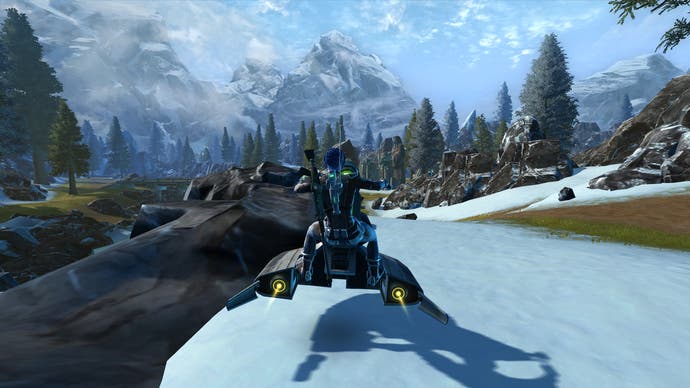
The Old Republic's biggest failing as a free-to-play game, though, is its attitude. It doesn't simply push you to subscribe. It levies so many petty restrictions that it ends up feeling like the goal wasn't to attract newcomers so much as spite any who dared show up. One of many examples: if you don't at least unlock Preferred status by spending a few quid (or returning to an old account), you're not allowed to Sprint until Level 15. Yes, that was the case at launch. It was changed shortly afterwards because the maps are huge, and getting around them at walking pace was and remains a deeply miserable experience.
Of course, BioWare needs to sell things to make this model work. That's not the problem, and most of what subscribers get is fine - early access to mounts, all-access passes to content and so on. The catch, as any game with the sweeties budget to enlist a six-year-old child could tell you, is that the free side of the game is just as important. The more people stick around, the more they're likely to buy - if not quick cosmetic stuff, then maybe extra maps or lockboxes or similar. All players matter, if not as VIPs to spoil right now, then as potential customers next month, or in three months, or next year.
The Old Republic has no time for this, preferring to treat non-subscribers as third-class citizens - even the ones willing to spend money on individual purchases. These unworthies earn no rested XP, with even regular XP being acquired at a lower rate. Quick Travel is now on a two-hour cooldown instead of half an hour. Even opening a shop window (not including the real money one) means getting a snippy "Vendor prices are increased for Free-to-Play Players".
This is not how subscribers are won. This is how 20GB of disk space is recovered.
"It's less like BioWare has set up a stall than actively taken offence that the game failed."
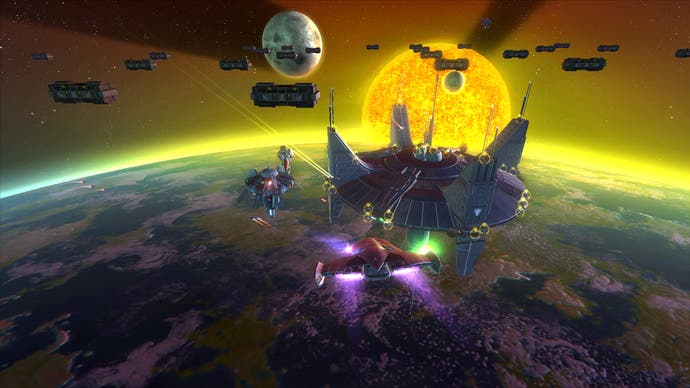
Medical Probes suffer from by far the worst change. In the original game, and to subscribers, these are free in-field resurrections - The Old Republic's answer to corpse-running in Warcraft. When questing, especially alone in the single-player-focused stories, the huge maps and regular last-minute interruptions from boss monsters make them essential. The design relies on them.
So obviously, they're now treated as luxuries. Non-subscribers have to buy them from the cash shop in packs of five, each costing an insane 500 space funbucks in a game where £2.99 only gets you 450. Refuse, and even if you're in an instance at the bottom of a dungeon, you get catapulted to a nearby base in the over-world. It's not guaranteed that all the enemies will have respawned by the time you get back; it's just 99.9% likely.
What's especially strange about all this - even ignoring the naked opportunism of things like forcing non-subscribers to pay about £2 to hide headgear items instead of having them welded on like particularly dorky leper bells - is what's not on sale. There's no character rename option, no chance to buy more than your two starting character slots, no race change service or even much in the way of cosmetic gear - not that the setting allows for that much variety. There definitely isn't the one thing I'd personally be happy to pay for - a way to experience the class stories without all the padding. The closest thing is a 25% XP boost lasting three hours, which barely even warrants this sentence.
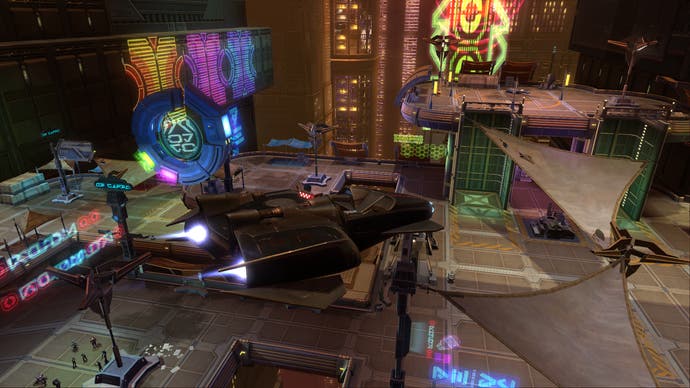
Over time, yes, all of this may be fixed and improved. As a starting point though, it's impossible not to see most of it as an acknowledgement that The Old Republic isn't a good fit for the free-to-play model and that BioWare isn't really that interested in it anyway. It's less like they've set up a stall than actively taken offence that the game failed.
Is it a complete disaster though? No. Despite all of the problems, the free option is still very playable, and The Old Republic still has its charms when the pieces come together and tell a good story. True, the Star Wars atmosphere is undercooked, but that doesn't mean you have to feel guilty about swinging a lightsaber for a while - and there are moments where you can see why BioWare thought betting the farm on this concept would make sense. Even if it didn't pay off.
As a top-tier MMO though, The Old Republic is done. Many games are said to have their day. The Old Republic's initial blaze of glory took that rather more literally than most, and this year's big releases have left it in the dust. Consider it on life support - and not the cool Darth Vader kind. The NHS kind. Surrounded by nurses who won't shut up about BUPA.
